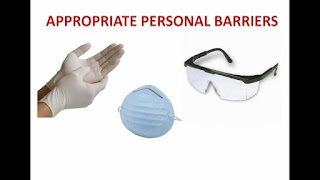Universal precautions refers to the practice, in medicine, of avoiding contact with patients' bodily fluids, by means of the wearing of nonporous articles such as medical gloves, goggles, and face shields. The practice was introduced in 1985-88. In 1987, the practice of universal precautions was adjusted by a set of rules known as body substance isolation. In 1996, both practices were replaced by the latest approach known as standard precautions. Use of personal protective equipment is now recommended in all health settings.
Video Universal precautions
Historical significance of universal precautions
Under universal precautions all patients were considered to be possible carriers of blood-borne pathogens. The guideline recommended wearing gloves when collecting or handling blood and body fluids contaminated with blood, wearing face shields when there was danger of blood splashing on mucous membranes and disposing of all needles and sharp objects in puncture-resistant containers.
Universal precautions were designed for doctors, nurses, patients, and health care support workers who were required to come into contact with patients or bodily fluids. This included staff and others who might not come into direct contact with patients.
Pathogens fall into two broad categories, bloodborne (carried in the body fluids) and airborne.
Maps Universal precautions
Use
Universal precautions were typically practiced in any environment where workers were exposed to bodily fluids, such as:
- Blood
- Semen
- Vaginal secretions
- Synovial fluid
- Amniotic fluid
- Cerebrospinal fluid
- Pleural fluid
- Peritoneal fluid
- Pericardial fluid
- Feces
- Urine
Bodily fluids that did not require such precautions included:
- Nasal secretions
- Vomitus
- Perspiration
- Sputum
- Saliva
Universal precautions were the infection control techniques that were recommended following the AIDS outbreak in the 1980s. Every patient was treated as if infected and therefore precautions were taken to minimize risk.
Essentially, universal precautions were good hygiene habits, such as hand washing and the use of gloves and other barriers, correct handling of hypodermic needles and scalpels, and aseptic techniques.
Equipment
Protective clothing included but was not limited to:
- Barrier gowns
- Gloves
- Eyewear (goggles or glasses)
- Face shields
Additional precautions
Additional precautions were used in addition to universal precautions for patients who were known or suspected to have an infectious condition, and varied depending on the infection control needed of that patient. Additional precautions were not needed for blood-borne infections, unless there were complicating factors.
Conditions indicating additional precautions:
- Prion diseases (e.g., Creutzfeldt-Jakob disease)
- Diseases with air-borne transmission (e.g., tuberculosis)
- Diseases with droplet transmission (e.g., mumps, rubella, influenza, pertussis)
- Transmission by direct or indirect contact with dried skin (e.g., colonisation with MRSA) or contaminated surfaces or any combination of the above.
Issues of stigma and discrimination
Research around stigma and discrimination in health-related settings has implicated universal precautions as a means by which health care workers discriminate against patients. Particularly the employment of universal precautions when working with people with HIV and/or hepatitis C has been demonstrated to be inconsistent and implicated with feelings of stigmatization reported by those populations. Health-cased social research reveals that by not applying universal precautions universally, as is the purpose, health professionals are instead making judgements based on an individual's health status. It is speculated that this differential approach to care stems from stigma towards HIV and hepatitis C, rooted largely in fears and misconceptions around transmission and assumptions about patient lifestyle and risk.
See also
- Barrier nursing
- Body substance isolation
- Viral hemorrhagic fever
- hepatitis -B
Footnotes
External links
- Recommendations for Prevention of HIV Transmission in Health-Care Settings
Source of article : Wikipedia

